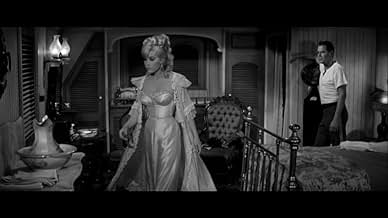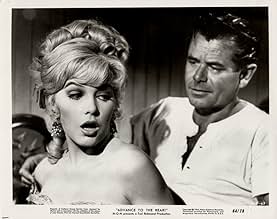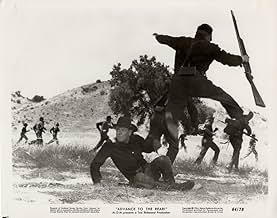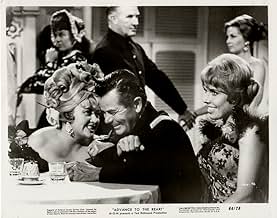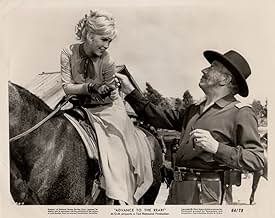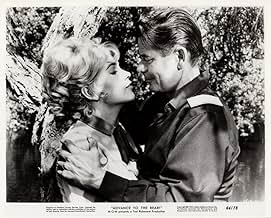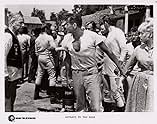Füge eine Handlung in deiner Sprache hinzuWhen A Union Army outfit of misfits and rejects is sent to the Western territory, Southern spies try to figure out what they're doing there.When A Union Army outfit of misfits and rejects is sent to the Western territory, Southern spies try to figure out what they're doing there.When A Union Army outfit of misfits and rejects is sent to the Western territory, Southern spies try to figure out what they're doing there.
- Sergeant Davis
- (as Alan Hale)
- Courier
- (Nicht genannt)
- Waiter
- (Nicht genannt)
- Steamboat Captain
- (Nicht genannt)
- Member of the Law & Order League
- (Nicht genannt)
- Trooper
- (Nicht genannt)
Empfohlene Bewertungen
Technically, the book was a historical novel, centred around the fictional character of Jared Heath, himself a disgraced Union officer, busted to sergeant, who was detailed to take charge of a company of other disgraced officers who had also been demoted for crimes such as desertion, disobedience, brawling and other such offences that are not tolerated in any Army, past or present. The end of the novel describes how Jared Heath and his "Company of Cowards" manage to redeem themselves during a heroic battle against Comanche and the Kiowa Indians, with a few of them giving their own lives in the heat of battle.
I should imagine that the producers and MGM had a lot of debate about how this film should be made. Was it to be a film about the true horrors of war and how disgraced soldiers were treated by the other troopers, as depicted in the novel? No, it was to be made as a knockabout comedy, directed by George Marshall, who had already directed James Stewart in "Destry Rides Again" and Glen Ford in a few other films, such as another comedy western, "The Sheepman".
A question had already asked as to whether the television comedy series, "F Troop" was loosely based on this film. Well, as the series was released on ABC a year later, it is probably more than a coincidence that the producers of the series did take some inspiration from this film. Ken Berry would have been a more naïve version of the Glen Ford character.
Jack Schaefer's novel was a very serious study on how the American Civil War was fought, which went on to describe the horror of fighting in the Indians Wars, when many hostile Indian tribes took advantage of the fact that the "white men" were distracted with fighting each other.
There were also some political comments about why the Union government kept changing its mind as to the reason for the war, starting out with political wrangles about why the Federal Government should have control over the distant Southern States; with the economic disparity between the Southern States and the Northern States; the need to keep the Union together; and, finally, the Abolition of Slavery.
Jack Schaefer wrote "Shane", one of the greatest and most realistic westerns ever written and filmed - I wonder what he thought of how his original novel was brought to the screen.
I will give the film 8 out of 10 for the lively performances of Glen Ford and the lovely Stella Stevens.
Regardless, I was sort of ho-hum about the Civil War part, but I thought I'd cheer up my poor husband who was sick with food poisoning (duck from a nice restaurant, not my cooking). I was already pretty interested after Robert Osborne's introduction before the first scene played. The setup before the credits was a good teaser, and by the time the credits rolled I was hopeful. I knew I was hooked the minute Glenn Ford was taunting the rebs with talk of fried chicken. Then I was absolutely rolling when Ford and Douglas had their first scene and the first of many disagreements. They played off of each other so well. Douglas had his leading man days in his younger years, but some of my favorite roles are supporting ones. He sparred superbly with Cary Grant in Mr. Blandings Builds His Dream House.
By now I'd made up my mind that this was in no way going to be a dreary Civil War film. The next test was Stella Stevens. I saw her in a cute Dean Martin film and was just so thankful she didn't have on a buxom bikini and a Swedish accent and ended up liking the movie. To my delight, she's a beautiful rebel spy that appears to still have her virtue. That's hard to find in movies now, but it really makes for a clean, fun classic film which is what I enjoy the most. Through a series of preposterous events, Ford becomes involved with Stevens and their chemistry was just perfect and their banter adorable.
The supporting cast included Joan Blondell, Alan Hale (Jr.), Jim Backus, and a lot of other familiar faces from my days of watching great TV and movies on rainy days long ago. The stunts were very creative, the horse scenes were humorous, the crazy Company Q was comprised of the most perfectly matched bunch of misfits. The only one remotely sane was Ford, the suave and charming straight man. Finally, the film actually had a plausible plot that ended up making sense and everyone happy. Other than a few over the top slapstick scenes, I enjoyed this silly treasure. It even got a few chuckles out of my sick husband before he fell back asleep.
What a great Sunday afternoon treat and one I'll want to see again! I highly recommend it to anyone who loves fun classic but totally unique quirky romantic comedy action adventure western war movies all in one.
I am going to have to track this down and plant it near THE HALLELUJAH TRAIL (another good comedy set in the same time period) on my viewing shelf.
During the last days of the Civil War, a contingent of Union soldiers, have made an uneasy accommodation with their Confederate counterparts stationed a few miles away. Every day at a certain time, each side fires a round of cannon fire at the other, timed to a deliberate miss. The aim of both sides is to, hopefully, last out the war in this manner: reasonably safe and secure.
This arrangement works quite well, until a brash headstrong Union Captain (played well by Glenn Ford)decides,on his own, to go out and capture a few of the "enemy". This of course forces their equally reluctant "enemy" to retaliate.
Ford's Commander,(played with exquisite timing by veteran actor Melvyn Douglas) is horrified. "What have you done?" he shouts at him, "take them back! How many times have I instructed you not to show initiative?" From this point on, the humor escalates and never ceases.
Staffed by some of the most recognized character actors of the time, we are treated to a highly skilled portrayal of an incredibly believable assortment of military misfits. What makes them believable is that their characterizations are delivered with depth. And this, in a sense, makes them somewhat realistic and all the more funnier.
This high caliber B-film is well scripted and, to it's credit, is finally being recognized for the cinematic gem that it is. My advice to all film lovers is to seek out this almost forgotten treasure. Trust me, you won't be disappointed.
Wusstest du schon
- WissenswertesThe steamboat used in this movie was originally built and used as the Cotton Blossom, in MGM's Mississippi-Melodie (1951). It was also used in Das Land des Regenbaums (1957) and Abenteuer am Mississippi (1960). In the 1970s, it was one of the props auctioned off by the studio.
- PatzerIn the scenes where the cannons fire 30 rounds, some of the cannons fire before their fuses are ignited.
- Zitate
Martha Lou: All right. Let's say, just for the moment, that I *am* a spy.
Heath: A very pretty one, too.
Martha Lou: That would make us enemies, Jared.
Heath: Yeah, of course it would. And, we'd be starting out at a point in marriage that takes some couples twenty or thirty years to achieve!
Top-Auswahl
- How long is Advance to the Rear?Powered by Alexa
Details
- Laufzeit1 Stunde 40 Minuten
- Farbe
- Seitenverhältnis
- 2.35 : 1
Zu dieser Seite beitragen



